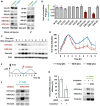Temporal regulation of gene expression through integration of p53 dynamics and modifications
- PMID: 39454005
- PMCID: PMC11506164
- DOI: 10.1126/sciadv.adp2229
Temporal regulation of gene expression through integration of p53 dynamics and modifications
Abstract
The master regulator of the DNA damage response, the transcription factor p53, orchestrates multiple downstream responses and coordinates repair processes. In response to double-strand DNA breaks, p53 exhibits pulses of expression, but how it achieves temporal coordination of downstream responses remains unclear. Here, we show that p53's posttranslational modification state is altered between its first and second pulses of expression. We show that acetylations at two sites, K373 and K382, were reduced in the second pulse, and these acetylations differentially affected p53 target genes, resulting in changes in gene expression programs over time. This interplay between dynamics and modification may offer a strategy for cellular hubs like p53 to temporally organize multiple processes in individual cells.
Figures




Similar articles
-
Acetylation of p53 at lysine 373/382 by the histone deacetylase inhibitor depsipeptide induces expression of p21(Waf1/Cip1).Mol Cell Biol. 2006 Apr;26(7):2782-90. doi: 10.1128/MCB.26.7.2782-2790.2006. Mol Cell Biol. 2006. PMID: 16537920 Free PMC article.
-
Distinct p53 acetylation cassettes differentially influence gene-expression patterns and cell fate.J Cell Biol. 2006 May 22;173(4):533-44. doi: 10.1083/jcb.200512059. J Cell Biol. 2006. PMID: 16717128 Free PMC article.
-
The p53 response in single cells is linearly correlated to the number of DNA breaks without a distinct threshold.BMC Biol. 2013 Nov 19;11:114. doi: 10.1186/1741-7007-11-114. BMC Biol. 2013. PMID: 24252182 Free PMC article.
-
Post-translational modifications of p53 tumor suppressor: determinants of its functional targets.Histol Histopathol. 2012 Apr;27(4):437-43. doi: 10.14670/HH-27.437. Histol Histopathol. 2012. PMID: 22374721 Review.
-
The impact of acetylation and deacetylation on the p53 pathway.Protein Cell. 2011 Jun;2(6):456-62. doi: 10.1007/s13238-011-1063-9. Epub 2011 Jul 12. Protein Cell. 2011. PMID: 21748595 Free PMC article. Review.
References
MeSH terms
Substances
Grants and funding
LinkOut - more resources
Full Text Sources
Molecular Biology Databases
Research Materials
Miscellaneous

